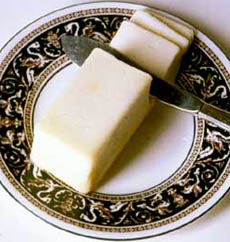Butter Glossary: A Glossary Of The Different Butter TypesPage 6: Butter Glossary R & S This is Page 6 of an 8-page article. Click on the red links below to visit other pages. This glossary is protected by copyright and cannot be reproduced in whole or part. You are welcome to link to it.
|
 Butter photo courtesy of Vermont Dairy. |
|
| RACREME See clotted cream.
|
||
| RANCIDITY Development of any off or disagreeable flavors in a fat. The four types of rancidity in fats are: absorption of odors, action of microorganisms, action of enzymes (lipases) and atmospheric oxidation. Butter primarily tends to become rancid due to the action of atmospheric oxygen, light, heat, water, metals, enzyme and microorganisms. Rancid butter becomes yellow to brown and the flavor becomes harsh.
|
||
| RUM BUTTER A compound butter made to sauce hot puddings. Butter is flavored with sugar, cinnamon, nutmeg and rum. A pat is placed atop the steaming pudding, where it melts into a sauce. This is known as a “hard sauce,” because it starts out in a solid state.
|
||
| SAUTÉ In French, sauté means “to jump,” and describes the method in which food is cooked quickly in a small amount of butter or oil. The food “jumps” as it is rapidly stirred or shaken over the heat.
|
||
| SCORE Refers to the grade of butter. Butter is graded, or scored, by government inspectors on the basis of its flavor, aroma, body and texture.
|
||
| SEASONAL VARIATIONS Because butter is an all-natural product made from the milk of cows, natural seasonal variations in the fatty acid composition occur based on the diet of the animals. These variations, however, do not affect the quality of the butter.
|
||
| SHORTBREAD A rich, crumbly cookie made of butter, flour and sugar. The classic way of making shortbread is to press the dough into flat decorative molds and cut it into wedges after baking. Enjoy this shortbread cookie recipe from one of New York’s prominent pastry chefs.
|
||
| SHORTENING Though the term most often refers to vegetable shortening, a solid fat made from vegetable oil such as soybean or cottonseed oil, any animal or vegetable fat can be used as shortening, including butter, margarine, lard or drippings.
|
||
| SMOKING POINT or SMOKE POINT The temperature at which butter begins to scorch and burn. A higher fat content butter yields a higher smoking point. To avoid smoking, clarified butter is used.
|
||
| SOUR CREAM Sour cream is not spoiled sweet cream: it is a dairy product made by adding a lactic acid culture to pasteurized sweet cream, producing a thick, creamy texture and a tangy flavor. Commercial sour cream contains from 18% to 20% butterfat, and often contains additional ingredients such as gelatin, rennin and vegetable enzymes.
|
||
| SWEET BUTTER A term often used for butter that has no salt; but this is a misnomer because any butter made with sweet cream instead of sour cream is sweet butter. The appropriate terms to use are unsalted butter and sweet cream butter.
|
||
| SWEET CREAM BUTTER Any butter made with sweet, as opposed to sour, cream. Both unsalted and salted butters can be labeled sweet cream butter; additionally, they will be labeled unsalted, salted or lightly salted.
Continue To The Next Page: Terms Beginning With T Go To The Article Index Above |
||
Last Updated Apr 2018
© Copyright 2005-2025 Lifestyle Direct, Inc. All rights reserved. All images are copyrighted to their respective owners.